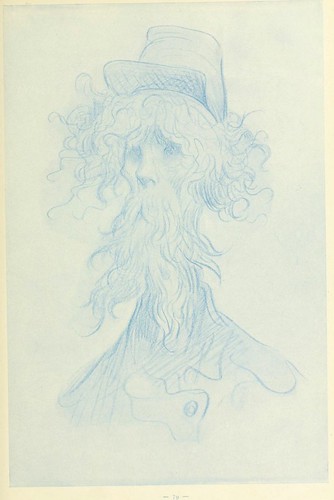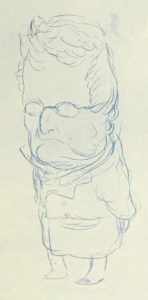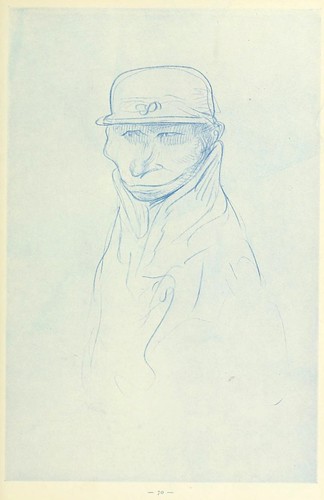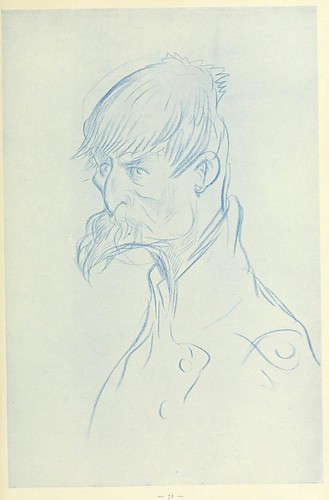I am a serious lover of, semi-serious scholar of (hemi-demi-semi-serious practitioner of) caricature. I’m here to deliver the goods.
Honoré Daumier is crowned 19th Century French master of this form. For so he is. But Gustave Doré, better known for his Dante, Bible and fairy tale illustrations, is as good, I say. The Internet Archive has a decent copy of Versailles et Paris en 1871, published in 1909. (Oddly, Wikipedia doesn’t even know it exists.) The Archive interface is ok, but this one needs a thumbnail gallery. Also, their PDF is messed up. So I made three Flickr galleries for the three sections of the book. First is “L’ Assemblée Nationale”. Next is: “La Commune”. Last is “Magistrature”. Then I realized I had nowhere to put the artist himself. Here he is. A Crooked Timber exclusive.
The best section is “La Commune”. All the Communards. Doré did not like them very much. But what makes these great is not that he’s vicious. He’s a brilliant character designer. There is so much variety in his faces. Here are a few of my favorites. I feel I have so much to learn from this. (All the ones I like best are in this soft, blue crayon style, but the vast majority are pen and ink. You’ll see.)
There are astounding anticipations here of styles I dearly love. Mervyn Peake is always trying to be this good. You might say it looks like Disney. Well, I consider that a good thing.
A while back I checked out Fantasy and Faith: The Art of Gustave Doré from my school library. Amazing, fun book. It’s not too expensive, looks like. Well, you decide. (I really want this one but I’m too cheap to shell out.) Doré was very successful in his day but his reputation seems always to have a been a bit out of joint, time-wise. He was a Romantic, a bit late for that party. These caricatures look like the future, however. The future of comics and animation.






{ 24 comments }
Adam Roberts 11.16.17 at 4:19 pm
Doré is amazing (as is Victor Hugo: I mean as an artist-caricaturist. But you knew that already). On our Victorian MA I teach a class on his collaboration with Douglas Jerrold, London: a Pilgrimage (1872): the BL has a selection of images from that wonderful book. One thing we touch on is the fact that Van Gogh had access to a copy of it in his Provencal boarding house, and when he wasn’t out painting cypresses and landscapes he was inside repainting Doré, making the black-and-white gloriously colourful. Compare, for example, Doré’s image of prisoners exercising at Newgate prison with Van Gogh’s canvas.
Adam Roberts 11.16.17 at 4:21 pm
(If I knew the art historical literature better I’d know if anybody had written a study of what Van Gogh owes to the traditions of nineteenth-century caricature. Because it’s clearlt a major line feeding into his practice. It is not to diminish his genius one jot or tittle, I think, to suggest that he creates in-a-sense caricature images when he paints).
Alan Bostick 11.16.17 at 6:06 pm
As a young college student I once found a copy of Balzac’s Droll Stories, illustrated by Doré, in the remainder section of a bookstore. I snapped it up. (Unfortunately, years later, I gave it up in a cull of our massively overpopulated bookshelves.)
The illustrations were line drawings, not engravings, and very much in this vein, full of caricature and grotesques.
Phil 11.16.17 at 8:31 pm
Goodness, yes – Peake really does look like a poor man’s Doré, once you’ve seen a bit of Doré. That’s not to say Peake’s stuff isn’t good – a working man’s Doré is something to be…
John Holbo 11.16.17 at 11:55 pm
That’s great, Adam. I didn’t know about that Van Gogh. That is indeed an important data point in the study of the history of caricature.
ph 11.17.17 at 3:45 am
I ‘m afraid I don’t see any connection between Doré and Van Gogh, or Van Gogh and caricature. I was doubtful, but intrigued enough to read a bit more. Doré is frequently described as a ‘self-taught’ prodigy. Blanche Roosevelt’s 1885 biography (Google Books) while not entirely definitive is probably much better than anything in Wiki, or in many modern studies. And it can be downloaded free. Roosevelt includes a very large number of early Doré works, including the illustrations he did for a book he prepared for a neighbour. His father was an engineer, and a surveyor, and would need to be handy with a pencil himself. Doré was an accomplished illustrator and caricaturist by the age of fifteen, in much the same way that Mozart was an accomplished composer as a youth. Lots of family and extended family support. Most of Doré’s early work was in the realm of caricature, but he cut his teeth on realistic depictions of landscapes and architecture, as we might expect from the son of an engineer and surveyor.
Everyone is entitled to an opinion on Van Gogh. My own is that he failed utterly to produce much of anything of interest to anyone until effectively abandoned his efforts to produce realistic illustrations of the sort most in demand by book and magazine publishers of the time. He retreated into his own world and his own vision of the world and found himself and his art, much of which is stunning and glorious. His rendering of Newgate may be superior to the original. Van Gogh’s copies, however, are very uneven. He lacked entirely the ability to produce anything in clear perspective. My guess is that he relied very heavily on the composition of the Doré original for the stability we find in the Van Gogh version. Van Gogh has as much in common with Doré as he does with Rembrandt, as in none.
On the question of caricature in the 18th and 19th centuries. It’s no accident that the 18th is often called the age of satire and we need look no farther than Hogarth for that. We have lots and lots of cartoons mocking the powers of the day. The nude, of course, was the test for all aspiring artists from the time of Da Vinci well into the 19th century, a test Doré passed with ease. Painters sometimes included obscene and other offensive material in renderings of their most famous works available only to private audiences, usually peers, which were later removed. The ability, then, to produce accurate, lifelike renderings of the human body was a skill demanded of all painters/artists worthy of the name. Both Delacroix and Gericault produced caricatures, as well as much more serious works. Humor and mockery is built into Watteau and Claude Vernet, and both his son and grandson produced a great many caricatures.
The 1885 biography seems a good read, highly recommended as a starting point.
John Holbo 11.17.17 at 4:03 am
“I ‘m afraid I don’t see any connection between Doré and Van Gogh, or Van Gogh and caricature.”
“My guess is that he relied very heavily on the composition of the Doré original for the stability we find in the Van Gogh version. Van Gogh has as much in common with Doré as he does with Rembrandt, as in none.”
Isn’t the fact that Van Gogh repainted Doré’s caricatures, as paintings, a connection? Thanks for the tip about an 1885 biography. I’m going to go check that immediately.
ph 11.17.17 at 6:23 am
7 Which Doré caricature did Van Gogh copy? I think you may rushed your reply.
Adam is welcome to his supposition that caricature informed Van Gogh’s work. It’s certainly possible. Nineteenth-century masters often produced caricatures with ease, and often as an exercise, elongating a nose, or chin, raising eyebrows, etc. Manipulating facial features was an essential skill for any portrait painter. Van Gogh lacked the basic skills to reproduce the human form. That doesn’t make him a ‘bad’ artist, but it doesn’t mean he was elongating and distorting perspective for artistic effect. The debate will likely continue. Van Gogh’s Millet is dreadful, but his Rembrandts – Lazarus and the Half-Angel are among his best. But none of these paintings are copies after caricatures. Are they?
Which Doré Van Gogh chose is worth considering for reasons and composition. His rendering of the Newgate crowd is uncharacteristically well-organized, and his manipulation of color and space greatly improves upon the original, and expands the emotional range of the Doré piece, which is unimaginative and predictably bleak. A masterpiece from a fine illustration, absolutely; but not a caricature, and not after a caricature, as far as I can see.
You’ve done good service to bring the Doré illustrations/caricatures to us all.
John Holbo 11.17.17 at 8:28 am
Oh, sorry I really was condensing a compound thought. Doré’s prisoners have a touch of caricature about them and Van Gogh’s color job leans into that. But it’s not really right to say that the prisoners are just caricatures, no.
John Holbo 11.17.17 at 8:38 am
The wobbly lumpiness of Doré’s prisoners reminds me of the wobbliness of his caricature stuff. Also of Daumier. The prisoners have a kinship with French caricature style. It’s partly in the bags and folds of the prisoner’s clothes to my eye. I don’t have much Daumier ready to hand this afternoon, but this:
http://wwwcdn.printmag.com/wp-content/uploads/C10257.jpg
John Holbo 11.17.17 at 8:47 am
Here’s another Daumier. You get all these extra folds in the drapes. I see that in the prisoners and in Van Gogh’s copy.
https://d32dm0rphc51dk.cloudfront.net/zPa4P9mMEQjsYpHgshuBaA/larger.jpg
I need to go dig up some lumpier Daumier stuff.
John Holbo 11.17.17 at 8:59 am
Kinda lumpy. Lumpy faces. You see that in the Doré prisoners.
https://uploads4.wikiart.org/images/honore-daumier/in-the-omnibus-1864.jpg
Eh, I give up.
ph 11.17.17 at 10:40 am
@9-12 Well, I rushed my own reply, if that’s any consolation. Tapping on the train.
I really do enjoy the images you put online for us. I confess I don’t see any humor in Van Gogh. I meant to say that Van Gogh’s decision to redo the Newgate Doré is very interesting for any number of reasons: swirls (a favorite motif), prisoners ambling in circles, some gaunt staring back at the viewer, the walls, and the foreground alive in ways the Doré is not. I’ve also had time to consider the positive impact of Van Gogh’s technical shortcomings. I don’t follow enough post-Van Gogh art in popular culture, but I’m open to the idea that his work did influence caricaturists, even if that wasn’t necessarily his intent.
You’ll enjoy Doré’s caricatures in the Roosevelt bio, especially the ‘autobiographical’ section of his childhood. Remarkable talent and eye.
John Holbo 11.17.17 at 11:03 am
I think it’s good not to assume that caricature = humor, even loosely. The proof of that is that there is a definite link between, say, the Carracci cousins caricature exercises and their Baroque style. Also, a lot of angry, ugly Modernism isn’t especially humorous.
Here is my personal scholarly take on the subject, for what it may be worth. I tend to see the stuff all over and under the bed.
http://www.academia.edu/27632961/Caricature_and_Comics
Adam Roberts 11.18.17 at 11:38 am
I’m with John; I don’t see that caricature must be comical or satirical. And it seems to me that the aesthetic shift from a nineteenth-century dominated by Academicism, neo-classical mimeticism and Pre-Raphaelitism to a late-century/20th-C art culture of Picasso et al could quite accurately be thumbnailed as realism reconfigured as caricature. Caricature in an as-it-were ‘neutral’ sense. Van Gogh is clearly closer to the versimilitudinous side of things than Picasso, Braque, Miro and all that crew—I mean, if we sketch out the spectrum of all those myriad aesthetic experiments. But he’s on their side of the equation surely. And Doré is closer to the mimetic even in the caricatures in John’s O.P. than Hugo, or Max Beerbohm, or whoever.
James Wimberley 11.18.17 at 3:14 pm
The Musée d’Orsay has an astonishing collectkon of 3D caricatures by Daumier in clay. Has any other artist ever done anything comparable?
ph 11.19.17 at 12:23 am
@14Thank you, James. Ceramic caricatures by Dantan the Young from the Musée Carnavalet: Liszt at the Musée Carnavalet and Paganini by Dantan, plus many others.
kent 11.19.17 at 2:18 am
Does the one in the hat (with almost a “Y” or a “P” on the hat) look just a bit like Putin? (Or am I just starting to see him everywhere?)
bob 11.19.17 at 5:06 pm
Better than the Internet Archive copy of the 1909 edition is the Hathi Trust copy of the 1907 edition of Versailles et Paris en 1871, which has sharper pdfs and includes thumbnails
https://babel.hathitrust.org/cgi/pt?id=hvd.fl1dpl;view=1up;seq=13
yabonn_fr 11.20.17 at 7:18 pm
If you like Doré, definitely check his Rabelais works.
John Holbo 11.21.17 at 2:53 am
Thanks, Bob. Looks like some login is needed for Hathi trust. I guess maybe it’s a library access thing. I’ll check that.
John Holbo 11.21.17 at 2:55 am
“If you like Doré, definitely check his Rabelais works.”
I have a nice copy of “Three Good Giants”. Sadly, the text is bowdlerized.
John Holbo 11.21.17 at 2:57 am
Ah, I’ll bet the Hathi link is registering that I am outside the US! Copyright law varies.
bob 11.21.17 at 7:41 pm
I’m not sure that being outside the US should be a barrier – the “What can I access without logging in?” portion of their Help page says
“All users can do the following without logging in:
Search across the entire collection;
Read and view works that are “full-viewâ€;”
https://www.hathitrust.org/help_digital_library#NoLogin
and under Help-General it says
“Works in the public domain in HathiTrust are open to all researchers—whoever and wherever they may be. Content in HathiTrust is discoverable through online search technologies within the repository and through Google, with no authentication, login, or password required.”
You might click their Feedback link to ask them why you are unable to get access. It would really be useful to have access to Hathi, since it has important digitized sources not available elsewhere.
Comments on this entry are closed.